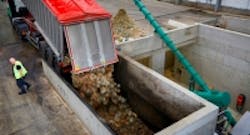Severn Trent Co-locating Food Waste Plant at Warwickshire Sewage Works
UK water utility, Severn Trent Water, is investing £13 million to build a new anaerobic digestion plant that will produce biogas from food waste at its Coleshill Sewage Treatment Works in Warwickshire.
According to the planning application the facility, which is currently under construction, will process and manage up to 48,500 tonnes of biodegradable organic waste per annum.
Rainwater collected from on-site surface water attenuation and the harvesting of rainwater that falls on the roof of the reception building can also be used in the AD process.
Once complete it is anticipated that the plant will generate around 2.4 MW of renewable energy.
According to Surrey the biogas facility should be operational by the end of the year.
“Once the digester at Coleshill is up and running, we have ambitious plans to roll out food waste plants across the Severn Trent region, and we’re looking at where we’re going to put the next two plants right now,” explained Mike Surrey, who’s overseeing the project.
“Each of these plants is expected to generate around 2%t of Severn Trent Water’s energy needs,” he added.
The Coleshill Sewage Treatment Works treats an average of 78,000m3 /day of raw sewage per day from the equivalent of 251,000 people along the east fringes of the greater Birmingham area. According to Severn Trent this figure may rise up to around 160,000m3 per day during inclement weather.
The treatment works consists of screening equipment for removal of gross solids, grit removal equipment, sedimentation tanks, aerated tanks to assist biological treatments and chemical dosing to assist final sedimentation. Treated carrier water, which the company said matches or betters quality standards prescribed by the Environment Agency, is returned to the River Tame.
Sewage sludge is pumped to Minworth STW for treatment before being recycled to farmland.
